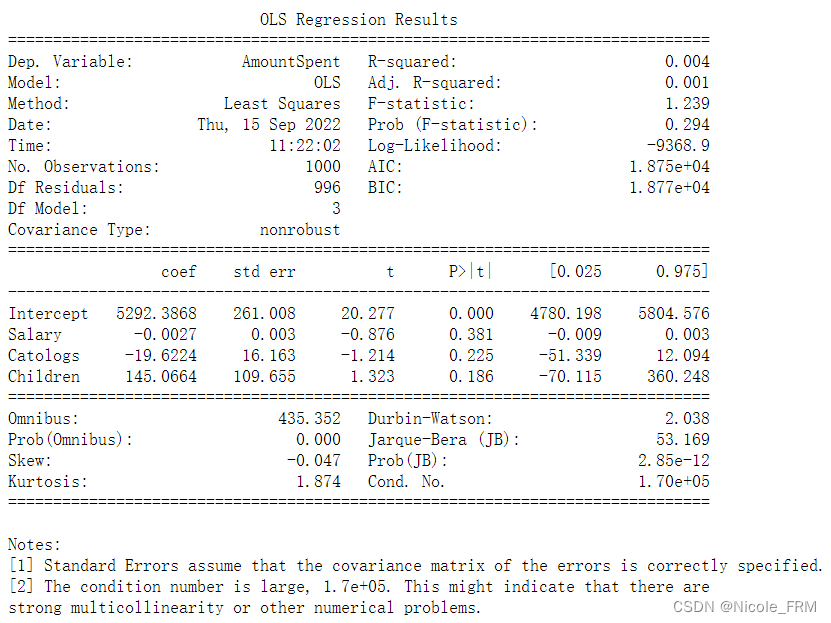statsmodels 最小二乘法 线性回归
最近使用到了ols做线性回归,记录一下使用方法
首先是statsmodels,根据官网介绍,这是python里一个用于estimate statistical models 和 explore statistical data 的模块,经常做数据分析的小伙伴应该都不陌生
statsmodels is a Python module that provides classes and functions for the estimation of many different statistical models, as well as for conducting statistical tests, and statistical data exploration. An extensive list of result statistics are available for each estimator. The results are tested against existing statistical packages to ensure that they are correct.
然后是ols的方法,悉大的tutor给到了api 和 formula.api 两种建模方法,感觉直接用formula更省事些,毕竟自己做老容易忘记加intercept >-<
方法一:statsmodels.api 做最小二乘法,需要自己添加intercept截距项
方法二:statsmodels.formula.api 通过自定formula和dataframe生成模型,无需添加截距项
-
import pandas
as pd
-
import numpy
as np
方法一:statsmodels.api 做最小二乘法,需要自己添加intercept截距项
1. 生成数据
-
data = pd.DataFrame({
'Salary':np.random.rand(
1000)*
100000,
-
'Catologs':np.random.randint(
1,
20,size=
1000),
-
'Children':np.random.randint(
0,
3,size=
1000),
-
'AmountSpent':np.random.rand(
1000)*
10000})
-
data.head()
2. 调用 statsmodels.api
import statsmodels.api as sm
3. 拟合模型
3.1 新增截距项
-
# 原有x,y
-
x = data[[
'Salary',
'Catologs',
'Children']]
# 注意是[[ ]]
-
y = data[
'AmountSpent']
-
-
# 新增截距项
-
x_with_intercept = sm.add_constant(x, prepend=
True)
3.2 OLS拟合,注意OLS要大写
-
# 拟合模型
-
model = sm.OLS(y, x_with_intercept)
# OLS 要大写,函数里因变量在前面
-
results = model.fit()
方法二:statsmodels.formula.api 通过自定formula和dataframe生成模型,无需添加截距项
1. 生成数据
-
# 生成数据
-
data = pd.DataFrame({
'Salary':np.random.rand(
1000)*
100000,
-
'Catologs':np.random.randint(
1,
20,size=
1000),
-
'Children':np.random.randint(
0,
3,size=
1000),
-
'AmountSpent':np.random.rand(
1000)*
10000})
-
data.head()
2. 调用 statsmodels.formula.api
-
# 直接调用formula,无需手动增加截距项
-
import statsmodels.formula.api
as smf
3. 拟合模型
3.1 明确要拟合的公式
-
# formula,"因变量 ~ 自变量1 + 自变量2 + ... + 自变量n"
-
formula =
"AmountSpent ~ Salary + Catologs + Children"
3.2 OLS拟合
4. 输出拟合结果,检验R-square, coefficient是否显著 etc.
print(results.summary())

PS:随机生成的数据果然挺随机的,这结果等于做了个寂寞
本文作者:TwcatL_tree
本文链接:https://www.cnblogs.com/twcat/p/16912384.html
版权声明:本作品采用知识共享署名-非商业性使用-禁止演绎 2.5 中国大陆许可协议进行许可。




【推荐】编程新体验,更懂你的AI,立即体验豆包MarsCode编程助手
【推荐】凌霞软件回馈社区,博客园 & 1Panel & Halo 联合会员上线
【推荐】抖音旗下AI助手豆包,你的智能百科全书,全免费不限次数
【推荐】博客园社区专享云产品让利特惠,阿里云新客6.5折上折
【推荐】轻量又高性能的 SSH 工具 IShell:AI 加持,快人一步